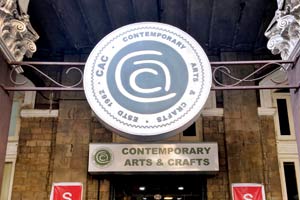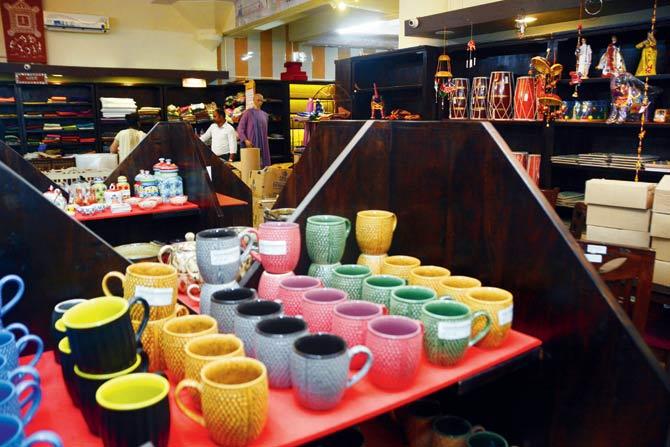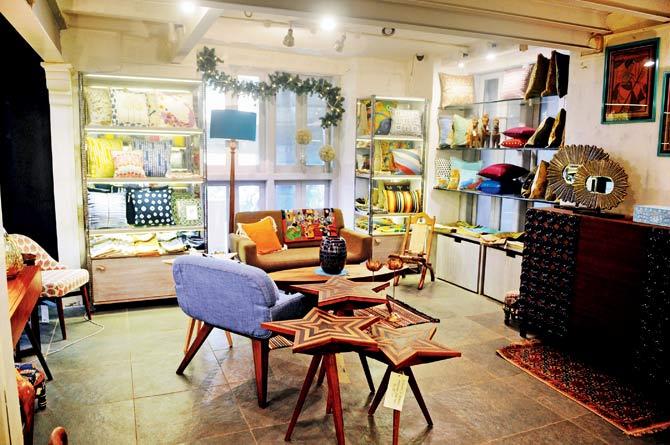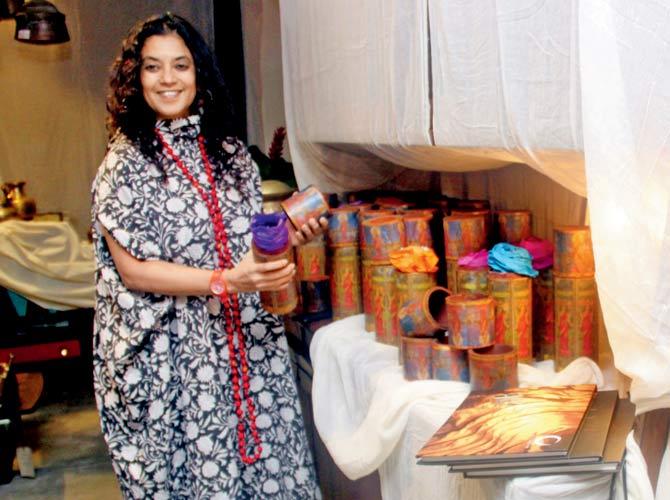With three handicraft stores shuttering this week, the story of the challenges of the crafts industry will be retold. What is Mumbai's part to play in this?

 The Central Cottage Industries Emporium's outlets in Fort
The Central Cottage Industries Emporium's outlets in Fort
Next week, Mumbai is set to lose two important crafts establishments - the Central Cottage Industries Emporium (CCIE), and, the city's oldest home decor store, Contemporary Arts and Crafts (CAC). On Fort's DN Road, a little walk from CSMT, is CCIE's outlet, its display windows overtaken by enthusiastic hawkers. It's yet to shut down, but the complete disregard for advertising would have you believe that the central government-run store has already called it a day.
ADVERTISEMENT

Colaba are set to close down this week after facing a loss of Rs 3.5 crore last year. Pics/Sneha Kharabe
Inside, dim tubelights make a half-hearted effort to draw attention to products placed limply on shelves. A copper and enamel diya - a lovely addition to your altar - costs R658, including GST. A classic bench made of sheesham costs R25,000. There is other bric-à-brac, such as papier-mache Easter eggs and textile purses, which exude an anachronistic 1980s vibe.

The CCIE's three Mumbai branches - in Malad, Fort and Colaba - have incurred a total loss of R3.5 crore, says Dinesh Kumar Mishra, general manager, marketing, CCIE. Concluding that it was a loss-making venture, the CCIE decided to bring down the shutters on one of its biggest centres.

Mumbai's first home decor store which had been going strong for 55 years and paid close attention to handicraft traditions, closes this week. Pic/Datta Kumbhar
Nearby, the swankier CAC, known for its uncompromising quality control and niche designs, announced its closure earlier this month. Feroza Mody, co-owner of the much-loved 55-year-old store, told mid-day in a report dated April 6 that tunnelling work for the Colaba-Bandra-Seepz Metro III line outside CAC's premises had blocked access to the store. It was the last blow on an already unprofitable crafts business in the brick-and-mortar model. Given that work for the Metro line will continue till 2021, with fewer footfalls month after month, it seemed like a sound decision. CAC will function through its online presence, and whether the store will re-open in Mumbai is undecided at present.

That India's crafts industry is faced with major challenges is a story that we have heard repeatedly. A 2013 report by Dasra, titled Crafting a Livelihood: building sustainability for Indian artisans, states that crafts 'have slowly lost relevance with the advent of industrialisation. Currently, the sector carries the stigma of inferiority and backwardness... This is compounded by the government's treatment of crafts as a sunset industry, which has resulted in a lack of well-developed policies and programmes to protect and strengthen the ecosystem for artisans.'
In 2016, FICCI released its report on the Creative arts in India, which states that the handicrafts industry employs about 7 million people, directly and indirectly. 'However, India's share in the world handicraft exports is less than 2%.' Are we, in Mumbai, now looking at another iteration of the challenges that the crafts industry continues to face in India? And, are we Mumbaikars apathetic to the many prospects that the industry has to offer?
The Mumbai problem
The CCIE's Malad outlet was housed within Shoppers Stop's furnishing section, and used to be an expansive set-up, with high-end teak beds reportedly going for about more than one lakh. The section was steadily downsized, until it folded up on March 31. CCIE's Colaba outlet, which once faced major litigation troubles, is the busiest of the three branches. "But, we need a self-sustaining model," says Mishra. "Most of our profits come from New Delhi, where we have our own showroom - it accounts for 70 per cent of our sales. In Mumbai, despite the prime locations, we cannot afford the rents quoted. We have incurred a loss of R10 crore overall," he continues. (Rental figures from CCIE were not available at the time of going to print).
"If you ever walked into a CCIE outlet, you would wonder if they were ever designed to lure customers. Like everything the government does, it just followed rules. CAC, on the other hand, is not shutting down because people are not interested. It's shutting down because of the space - ridiculous rents, Metro digging that is a nightmare, ineffective marketing and so on," says Srila Chatterjee, who runs a design store in Lower Parel. She adds, "Mumbai's peculiar perennial challenge: the cost of real estate. I don't really have an answer on how to overcome this."
Aradhana Nagpal knows the feeling first-hand of having to size down her crafts and design store, Dhoop. After her Khar-based craft-conscious product store opened in 2004, it quickly earned the reputation for quality and aesthetics. Last year, however, the axe fell upon it in the form of rental costs and competition from online contenders. Nagpal decided to shut down the brick-and-mortar store, continuing to function as a studio, and maintain an online presence. Around the same time, the city saw the closure of kitsch crafts store, Tappu ki Dukaan, and vintage-chic store, Sanctum.
The Mumbai customer, as Nagpal puts it, tends to follow the scent of trends and brands quickly. If there is a current global shift towards sustainable fashion and fair trade, she vouches that the Mumbai customer has caught on, but does so in a superficial manner, without paying attention to provenance or artisanal technique. "That said, Mumbai is interested in a quality product, be it kitsch or handicraft.
But, the interest in sporting brands rather than supporting local artisans needs to change," she says. A comparison between New Delhi and Mumbai yields a reaction from Shibani Jain, whose store in Lower Parel dedicated to handicrafts, and folk and tribal art, re-opened yesterday. "Mumbai is a different cup of tea. Delhi is used to heritage, having been part of the Golden Triangle [with Agra and Jaipur]. As a commercial and financial centre, the sensibilities of the Mumbai crowd are more contemporary," says Jain.
Chatterjee disagrees, however. Customers are not really different - Mumbai ones are just less exposed and therefore have very limited knowledge, she says, but the challenge is to educate them to love the handicraft traditions better. "Every other comparable city has markets, bazaars, fairs and emporia dedicated to craft that are easily accessible and well-known. That is probably the reason why both knowledge and interest are so far behind in Mumbai.
The success of shows like the Paramparik Karigar are indicators of people's genuine interest in everything on offer, but these are drops in the ocean. It's absurd that there is no crafts museum in this city," she says. Unlike New Delhi's State Emporia Complex on Baba Kharak Singh Marg, Mumbai has no such space, apart from the ubiquitous malls, that showcase India's central and state emporiums. The Capital's State Emporia Complex boasts wares from Tamil Nadu, Gujarat, Madhya Pradesh and many more states. There is also Kamala, the shop run by the Crafts Council of India.
Support local
Radhi Parekh runs a popular gallery dedicated to art, craft and design in Kala Ghoda, named ARTISANS'. She says that it's a location in Mumbai that has more footfalls, the kind of luck that establishments in the Fort area do not have anymore, given the northern movement of the commercial hub of the city. It is also the kind of advantage that the CCIE has in New Delhi, at Janpath, where a number of tourists and well-connected bureaucrats come by. The biggest customer for handicrafts is the itinerant kind, she says. "The visitor to India, the NRI and Indians travelling abroad looking to gift people - they form a major segment of the clientele in the city. It is true that the 'India story' is a big draw for them," she says. But, what about the locals? Parekh says that while Mumbaikars are turning towards handmade in India, they seem enamoured by brands, especially international ones, and their desire to embrace handloom textiles, for instance, is accompanied by anxiety, even among those with disposable incomes. "Handloom textiles are just beginning to be perceived as being 'cool' by younger clientele, who prefer opting for global designs," she says.
Ahmedabad-based Ashoke Chatterjee, honorary advisor with the Crafts Council of India, says that even if CCIE hasn't been able to sustain the highest standards of market leadership in recent years, its achievements need to be saluted. "When it started almost 70 years ago with the voluntary effort under the inspiration of Kamaladevi Chattopadhyay [the freedom fighter and feminist social reformer who set up national institutions such as the National School of Drama and Sangeet Natak Akademi], CCIE set standards which the rest of us have followed. It should be remembered that CCIE, CAC and a few others were the real pioneers in creating demand for handmade quality in the years after Freedom. They were an expression of what Independence meant in terms of identity and aspiration. If CCIE has failed in Mumbai, we may need to first understand why it has suffered losses. The city remains at the top of retail opportunity, and regularly demonstrates its demand for handmade quality and its status as the Big Apple magnet for artisans throughout the country," he says.
The lessons may be more about management and competition around the corner in Colaba Causeway, where there are local stalls and hawkers selling real and fake handicrafts by the dozen, as well as from other outlets, and less about demand. However, the industry needs more surveys and reports to adequately understand the situation, and we will need to wait for more data.
The closing down of these establishments in Mumbai means there is a need to zoom out and look at the big picture simultaneously - what of the artisans that these establishments work with? What of the employees? Entrepreneurs and experts say that the challenges of the past continue to exist even today - ensuring that price points of products are such that the artisan's share is not affected, and the need for better policies from the government, are just some such.
In recent times, the biggest blow to the artisan, and therefore to establishments, has been demonetisation and the introduction of the GST. The current ambiguity over GST rates for different kinds of handicrafts, under which term comes a diverse range of products, has reportedly brought down sales. The GST slab can be anywhere between zero per cent to 12 per cent, impacting the final pricing of the product. "Unstitched handloom cloth carries 5 per cent GST, while stitched carries 12 per cent. This has to be borne by the customer, but let us keep in mind that we can afford to pay more so that it doesn't eat into the margins of the artisans," says Siva Devireddy, founder and CEO of e-commerce platform, GoCoop.
In the meanwhile, Mishra says that employees of the CCIE will be transferred to their other branches, and the artisans they work with will continue to be sought out as well. In the future, the CCIE will look to open a branch again in Mumbai, but, hopefully, without having to bear astronomical rents.
Catch up on all the latest Mumbai news, crime news, current affairs, and also a complete guide on Mumbai from food to things to do and events across the city here. Also download the new mid-day Android and iOS apps to get latest updates
 Subscribe today by clicking the link and stay updated with the latest news!" Click here!
Subscribe today by clicking the link and stay updated with the latest news!" Click here!







